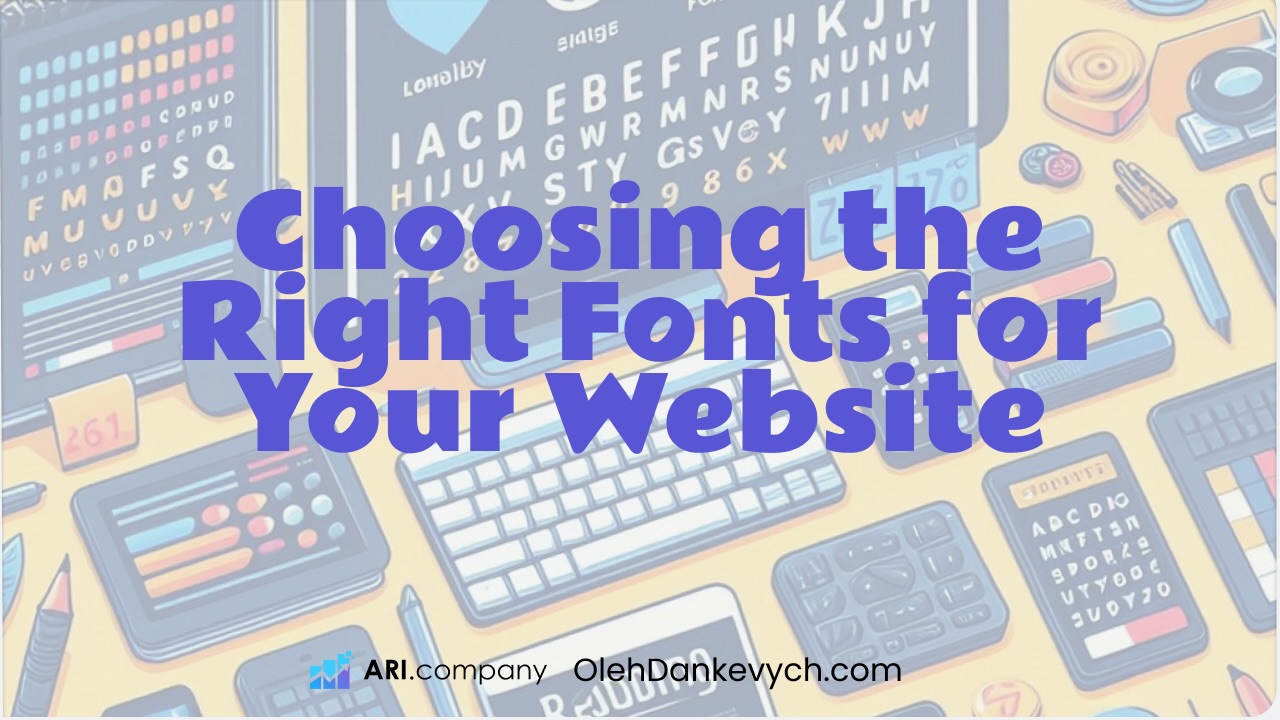Choosing the Right Fonts for Your Website

Choosing the right fonts is an important part of designing your website. It can make a big difference in how easy it is for people to read and how they see your brand. Here are some tips to help you choose the right fonts:
Readability First
Readability should be your top priority when selecting fonts for your website. If visitors cannot easily read the text on your site, they will likely leave quickly, and you may lose potential customers or readers. Here are some key points to consider for enhancing readability:
- Sans-Serif Fonts: Sans-serif fonts like Arial, Helvetica, and Verdana are often easier to read on screens. These fonts lack the small projecting features called “serifs” at the end of strokes, making them cleaner and more straightforward in appearance.
- Font Weight: Choose a font weight that is not too light or too bold. A regular or medium weight is generally a safe choice for body text. Light fonts can be difficult to read on some screens, while overly bold fonts can be overwhelming.
- Line Spacing: Adequate line spacing, also known as leading, improves readability. Too little spacing makes the text look cramped, while too much spacing can make it hard to follow the lines.
- Avoid All Caps: Using all capital letters for long passages of text can be hard to read. Save all caps for short headlines or emphasis.
Limit the Number of Fonts
Using too many different fonts on a single 🔗 website can create a cluttered and inconsistent look. Here are some guidelines to help you maintain a clean and cohesive design:
- Two to Three Fonts: Stick to no more than two or three different fonts throughout your website. A common approach is to use one font for headings and another for body text. If you need an additional font for special elements, use it sparingly.
- Font Families: Consider using different weights and styles within the same font family. For example, you can use bold, italic, and regular versions of the same font to create variety while maintaining a cohesive look.
- Brand Consistency: Make sure the fonts you choose align with your brand identity. Consistency in font usage across all your marketing materials, including your website, reinforces your brand.
Size Matters
The size of your text is crucial for readability and user experience. Here are some tips for choosing the right font sizes:
- Body Text: The body text should be large enough to read comfortably. A common size for body text on websites is between 16px and 18px. Adjust this based on your specific font and audience needs.
- Headlines: Headlines should be noticeably larger than body text to draw attention and provide a clear hierarchy. A good rule of thumb is to make headings at least 1.5 times larger than the body text.
- Responsive Design: Ensure that your font sizes are responsive, meaning they adjust well on different screen sizes and devices. Test your website on various devices to make sure the text remains readable.
Contrast
Contrast between the text and background is essential for readability. Without sufficient contrast, your text can blend into the background, making it difficult to read. Consider these points:
- Dark Text on Light Background: This is generally the easiest to read. Examples include black or dark gray text on a white or light-colored background.
- Light Text on Dark Background: This can also be effective but should be used carefully. Ensure the text is bright enough to stand out against the dark background. White text on a black or dark blue background can work well.
- Avoid Busy Backgrounds: Backgrounds with patterns or images can make text difficult to read. If you use a patterned background, consider adding a solid color overlay with reduced opacity to improve readability.
- Accessibility: Make sure your color choices meet accessibility standards. Tools like the WebAIM Contrast Checker can help you determine if your text has sufficient contrast for users with visual impairments.
Importance of Choosing the Right Fonts
The fonts you choose for your website do more than just present information—they communicate your brand’s personality and values. Here are some additional reasons why font choice matters:
- Brand Identity: Fonts can convey a lot about your brand. A playful font like Comic Sans might suggest a fun, casual brand, while a more traditional font like Times New Roman can convey professionalism and reliability.
- User Experience: Good font choices improve the overall user experience by making your content easier to read and navigate. This can lead to longer time spent on your site and higher conversion rates.
- First Impressions: Visitors often form an impression of your website within the first few seconds. Clean, readable fonts help create a positive first impression.
- Emotional Impact: Different fonts can evoke different emotions. For example, script fonts can add a touch of elegance and sophistication, while sans-serif fonts often feel modern and straightforward.
Choosing the right fonts for your website is a critical aspect of web design that affects readability, user experience, and brand perception. By prioritizing readability, limiting the number of fonts, selecting appropriate sizes, and ensuring sufficient contrast, you can create a website that is both visually appealing and easy to navigate.
Remember, the goal is to enhance the user experience and convey your brand’s message effectively. Thank you for reading!